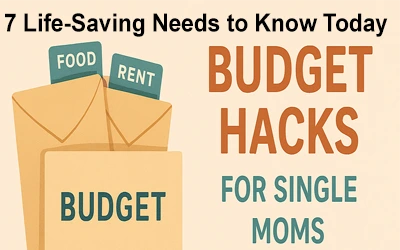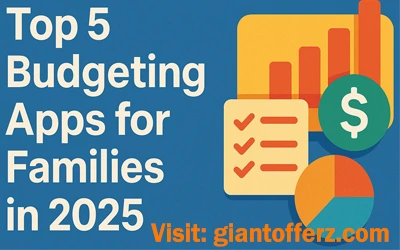
How To Teach Kids About Money
Why Teaching Kids About Money Matters More Than Ever
Money touches everything in adult life — from where we live to how we feel about security. And yet, most kids in America grow up learning nothing practical about it. Schools often skip the subject, and many parents wait too long, unsure where to begin.
But kids are watching. They notice how you swipe a card, pay bills, talk about stress. Without clear guidance, they absorb habits silently — good or bad.
Here’s the truth: You don’t need to be a finance expert. You just need small, intentional steps that feel natural and engaging — not preachy. Whether your child is five or fifteen, this guide will help you build money-smart habits in your home starting today.
Age-by-Age Roadmap: When and What to Teach
Ages 3–5: Play-Based Money Awareness
At this age, kids are curious. They learn by watching, touching, and mimicking.
- Let them play store using coins and pretend food.
- Teach simple words like “save,” “spend,” and “share.”
- Let them drop coins into a clear jar and watch it fill.
Even if they can’t count yet, these little rituals plant deep seeds of money awareness.
Ages 6–9: Introduce Choices and Tradeoffs
Kids can now distinguish between “wants” and “needs.”
- Give a small allowance and let them decide how to use it.
- Create three jars: Save, Spend, Give.
- Ask questions like, “Do you want this toy now or save for that game later?”
Let them make small mistakes — that’s how real learning happens.
Ages 10–13: Real Budgeting, Real Consequences
This is the golden window to teach discipline and independence.
- Encourage earning through simple jobs (dog walking, helping neighbors).
- Set saving goals (a bike, a tablet).
- Involve them in budgeting for family outings or groceries.
- Start introducing online banking tools for kids.
Let them learn delayed gratification — one of the strongest predictors of financial success.
How To Teach Kids About Money
Ages 14+: Simulate Adult Financial Life
Teenagers are almost adults in behavior and tech use — treat them accordingly.
- Help them open a student checking/savings account.
- Teach how debit cards work (and how they differ from credit).
- Talk openly about monthly bills and the cost of life.
- Use investment simulation apps (like Stockpile or Greenlight) to explore stocks and long-term growth.
They’ll make decisions soon — prepare them now, not later.
Turn Everyday Moments Into Money Lessons
You don’t need a curriculum — just awareness.
At the Grocery Store
- Give your child $10 and ask them to find items for the week.
- Teach unit price comparison (“Is this bigger pack cheaper per ounce?”).
- Show how coupons or discounts affect the final total.
This makes budgeting real and visual.
When Paying Bills
- Explain what utilities are, how rent works.
- Let them see your spreadsheet or budget app.
- Emphasize due dates and consequences of late payments.
Money management becomes less mysterious when they see it unfold.
During Holidays and Birthdays
- Encourage saving up for buying a sibling or friend a gift.
- Teach about generosity and planning ahead.
Real-life events offer real-life motivation.
How To Teach Kids About Money
Make It Fun, Not Forced: Tools Kids Actually Enjoy
Games That Teach
- Monopoly (Junior or Regular): Concepts like rent, cash flow, risk.
- The Allowance Game: Teaches earning and spending.
- Cashflow for Kids (by Robert Kiyosaki): More advanced, teaches assets and liabilities.
Apps That Help
- GoHenry: Kid debit card with parent controls.
- Greenlight: Teaches budgeting and saving.
- BusyKid: Allows kids to earn allowance for chores and invest a portion.
These gamified tools do more than lectures ever could.
Books They’ll Actually Read
- “The Berenstain Bears’ Trouble with Money” (younger kids)
- “Finance 101 for Kids” (older children)
- “Smart Money Smart Kids” (teens, co-written by Dave Ramsey and his daughter)
Reading about money from relatable characters makes concepts stick.
Allowances: Give or Not Give? Here’s the Real Deal
There’s no perfect answer. But here’s what works for most US families:
- Don’t just give it. Let them earn it.
Chores = Effort = Money. That’s a message they’ll carry into adulthood. - Keep it predictable.
Whether it’s $1/week or $5/week, consistency is better than amount. - Don’t rescue them.
If they blow it on candy and have no money left for a friend’s gift — let the moment teach.
Allowance isn’t about the dollar — it’s about the discipline behind it.
Talk Openly: Break the “Money is Taboo” Cycle
In many households, especially where money is tight, it becomes a hush-hush topic. But this silence creates shame, confusion, and often poor decisions later in life.
Be real. Tell your kids when things are tight — not to scare them, but to involve them in smart choices.
Say things like:
- “We’re skipping takeout this week so we can put more in savings.”
- “We’re choosing the park instead of the movies — that saves $40, right?”
Inclusion breeds understanding and respect.
Teach Them About Digital Money — Before TikTok Does
Today’s kids grow up with apps, virtual currencies, and social media influencers pushing spending. If you don’t guide them, the internet will.
Teach App Spending Awareness
- Show them how buying one $0.99 game add-on 10 times = $9.90 gone.
- Discuss how auto-renewals drain money.
- Use real bank app screenshots to show activity.
Introduce Safe Online Banking
- Start with joint accounts or kid-controlled apps like GoHenry.
- Teach password safety, scam awareness.
- Let them review real transactions and monthly statements with you.
The earlier they face online finance, the safer they’ll be.
Introduce Investing — Even in Simple Terms
No, your child doesn’t need to understand the S&P 500. But they can learn that money grows when it’s saved and invested wisely.
Simple Ways to Teach It
- Say: “If you put $5 in a jar each week, how much will it be in 3 months?”
- Use apps like Greenlight or Stockpile to buy fractional shares in Apple or Disney.
- Track progress together once a month.
Let them feel ownership of their financial future — even at age 12.
Mistakes Are Lessons, Not Failures
Let’s say your child wastes $20 on something silly. Don’t shame them. Sit with them. Ask:
- “Was it worth it?”
- “What would you do differently next time?”
Help them reflect, not regret. No adult handles money perfectly — why expect kids to?
How To Teach Kids About Money
Helpful Resources for Parents
| Resource Type | Name | Purpose |
|---|---|---|
| Book | Finance 101 for Kids | Step-by-step money logic for tweens |
| App | Greenlight | Debit card + budgeting tools |
| Website | Jump$tart Coalition | Free money education content |
| Game | Cashflow for Kids | Fun investing simulation |
Bookmark these — they make teaching way easier.
Get $1000 Cash Rewards Credit Card
Receiving an offer for a $1000 cash rewards credit card is not just an opportunity—it’s a smart step toward better financial management. Typically, with this type of card, you can earn up to $1000 in cashback or rewards by meeting certain spending requirements or conditions.
How to Redeem?
- Click the “Redeem $1000 Cash Reward” button below to visit the offer page.
- Open an account—no money or credit card information is required. You’ll just need your name and a valid email address.
- You’ll be asked a few simple questions, such as your opinion about the brand, to review a product, or what you would do with the $1000 cash. Answer thoughtfully.
- After reviewing your responses, if you qualify, you will be notified by email.
Important: Thousands apply, but only about 1% are selected to receive the reward. You will never be asked for any payment or your bank or credit card details.
If selected, you might be asked to do some simple tasks like data entry or logistics based on your skills. This is a great opportunity, especially for those looking for flexible work from home or part-time jobs.
Where Can You Use It?
- Use your cash rewards for everyday purchases like groceries, gas, or dining out.
- It’s also perfect for travel expenses, hotel bookings, or flight tickets.
- Spend it anywhere your card is accepted, making your daily transactions easier.
- Some cards allow you to transfer rewards to savings or investment accounts for future growth.
How To Teach Kids About Money
Frequently Asked Questions
Q: When is the best age to teach children money management?
Answer: The best age for children to build the foundation of money management is 3 to 5 years. At this age, they learn everything by watching, listening, and imitating. So there is no need to teach complex financial concepts. Rather, letting them play in a toy store, depositing coins in a transparent jar, and teaching them the words “save”, “spend”, and “share” is enough. Even if they do not understand the value of money, they develop habits. These habits help increase their financial confidence in the future. The point is, the earlier it can be taught, the deeper it is embedded.
Q: What can be an effective money education strategy for children?
Answer: A good money education strategy can be – giving real-life experiences. Suppose you give your child 5 dollars and tell him that he can spend or save it as he pleases. This opportunity to make decisions teaches him what is essential, what is a luxury, and what happens when he makes a mistake. In addition, a jar with three categories – ‘save’, ‘spend’, and ‘give’ – can be set up. As they share the coins, the importance and practical aspects of money are learned naturally. It’s not a boring lecture, but rather easy, playful learning.
Q: How to teach children the value of money?
Answer: The best way to teach children the value of money is to give them opportunities to earn money. They can earn money by doing small tasks like watering plants or doing housework. When they earn money through their own labor, they understand its importance. Then they can be explained the importance of saving, spending, and waiting for big purchases. It is also good to have them participate in small ways in household budgeting, such as comparing prices when shopping in stores. The value of money can be taught not by words, but through experience.
Q: Can children get a credit card?
Answer: Legally, children cannot get a credit card in their own name until they turn 18. However, many parents make their children “authorized users” of their cards from the age of 13. In addition, apps like Greenlight and GoHenry provide kids with debit cards, which act as an alternative to credit cards. With these, they can learn to use cards safely, but without the risk of debt or interest. This helps them learn the safe use of digital money.
Q: How should children be taught about credit cards?
Answer: The first step in teaching children about credit cards is to provide clear examples. Show them monthly statements and explain how the bank advances money and charges interest if you don’t pay it back on time. You can give an analogy like borrowing a toy that has to be paid back on time. Have them review a transaction on a family credit card. The goal is to teach responsibility, not fear.
How To Teach Kids About Money
Q: What is the best credit card for children?
Answer: While there are no separate credit cards for children, kids’ debit card apps like Greenlight, GoHenry, and BusyKid are great. They can help them control their spending, savings, and investments, and parents can keep an eye on them. Including teenagers as “authorized users” on some credit cards like Capital One or Chase is also a good option, as it helps build a credit history.
Q: How do you explain the difference between “want” and “need” to a 6-year-old?
Answer: It is not easy to explain “want” and “need” at the age of 6, so give examples from everyday life. For example, when going to the store, say, “I need milk, and I want sweets.” Let them make small decisions and see the consequences, “Will you buy a toy now or save for a big one?” Using three jars (spending, saving, donating) also helps. They understand better if they do it simply and practically.
Q: How to teach teenagers about budgeting and saving?
Answer: Teenagers are ready to participate in real-life money management. Arrange for them to open a student bank account and teach them how to use a budgeting app. Encourage them to keep track of their income and expenses. Involve them in budget planning for school events or parties. Explain the importance of saving before spending. This way they will feel financial independence and responsibility.
Q: Which apps are good for teaching children about money management?
Answer: Popular apps for teaching children about money management are Greenlight, GoHenry, and BusyKid. With Greenlight cards, they can learn to spend, save, and invest, while parents can keep an eye on them. GoHenry offers chore tracking and spending limits. BusyKid lets kids earn money by working, then gives them options to save, spend, and donate. These apps are ideal for kids ages 6 to 17.
Q: How to introduce the concept of investing to kids?
Answer: Start by teaching them simple questions like, “If you save $2 a week, how much will you have in 3 months?” Then, let them buy shares in small companies using the Stockpile or Greenlight apps. See the results each month. Even if it’s not complicated, it will spark their curiosity and help them understand the importance of long-term savings.
Q: Should kids get an allowance from their work?
Answer: Yes, getting an allowance from their work teaches them the importance of earning money. They develop a sense of responsibility when they earn money for small tasks like cleaning their house, helping with chores, etc. Don’t just give them money for free. Working and giving money regularly and consistently becomes their way of life.
Q: What types of games are good for teaching children about money?
Answer: There are many popular games, such as The Allowance Game, Cashflow for Kids, and Monopoly Junior. These games teach children about earning money, budgeting, borrowing, and taking risks through play. They get real-world experience of profit and loss, which is safe and educational.
How To Teach Kids About Money
Conclusion: Raise a Child Who Doesn’t Fear Money — but Understands It
We don’t raise kids just to survive. We raise them to succeed.
And financial education is no longer optional — it’s survival.
By making money a normal, respectful, and engaging topic in your household, you’re not just teaching numbers — you’re giving your child the tools to make smart choices, avoid debt traps, and live with confidence.
Forget the lectures. Forget the guilt.
Start with a jar, a small chore, or a short walk to the bank.
Let your child see money, touch it, talk about it — and slowly master it.
Their future self will thank you.
How To Teach Kids About Money
Discover top picks that save you more, every day:
The Versatility of $100 Shein Gift Card
Redeem a $100 Walmart Gift Card Balance Online – Safe Method



